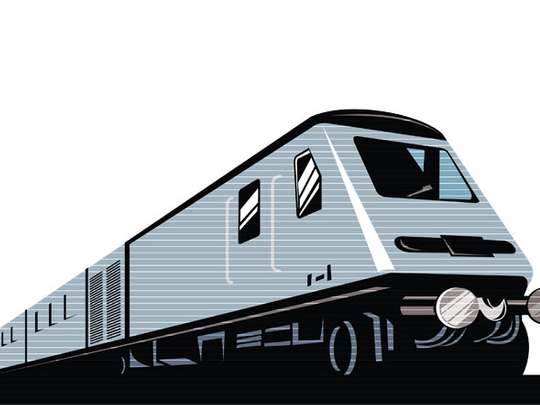
A railway network linking the six countries of the Gulf Cooperation Council is likely to be launched by 2017.
It's a move that is expected to start a rail "revolution" in the desert sands, allowing easier movement among the member states of the Gulf Cooperation Council (GCC), boosting inter-trade and further cementing their 29-year-old alliance.
The multi-billion dollar project has already received the endorsement and blessings of the heads of GCC states in their latest summit in Kuwait last December, paving the way to implementing what is seen as a vital project in the region. The GCC states are Saudi Arabia, UAE, Kuwait, Bahrain, Qatar and Oman.
"They (GCC leaders) are very enthusiastic about it," said Ebrahim Al Sabti in an interview with Gulf News. Al Sabti is head of the transportation division at the GCC secretariat in Riyadh.
"The endorsement of the project by the GCC leaders came after conducting feasibility studies," Dr. Ramez Al Assar, senior World Bank adviser to the secretary-general of the GCC, said. "That was the first phase and this is very important."
The beginning of the implementation phase includes conducting the engineering studies and the establishment of a "Gulf Railway Authority" to supervise the project. Conducting the engineering studies could take up to two years.
Design bid
While some in the Gulf expect the design contract to be given to a single entity which could to be announced by the end of the year, other sources say some ideas may not be accurate.
"The winner of the bid could be one consortium or more than one party," Al Assar said, adding that the number of winners will depend on whether the project will be divided into several parts or not.
Meanwhile, until the railway authority is formed — which is expected to be approved in the next summit scheduled to be held in Abu Dhabi in late 2010 — the current committee will continue carrying out its duties, GCC officials said.
The current committee includes senior officials from the ministries of finance, economy and transportation in the member states, as well as advisers from different institutions, including the World Bank.
Actual construction of the project will start after the completion of the engineering studies and after receiving the go-ahead from the heads of GCC states.
Eache country is expected to cover the cost of the part of the railway that passes through its territory. The link will start in Kuwait and pass through each GCC state on its way to Oman. The cost of the nearly 2,200 km project ranges, according to feasibility studies, is between $15 billion (Dh55.09 billion) and $25 billion, noted GCC sources. The difference is due to the type of train to be used.
"It will be a railway with dual usage," Al Assar said, explaining that it will cater to both passenger and freight traffic.
While the passenger train, expected to be electro-mechanical, will have a 200km/h speed, freight trains will have a speed of 80km/h to 120 km/h.
"But both trains will use the same infrastructure — the same track," Al Assar explained.
Apart from the cost and speed limits, experts say that the biggest challenges for the GCC countries will the issues of operational maintenance, custom fees and immigration. No decisions have been made on those issues.
However, once those are resolved, the railway will likely be able to offer a cheaper transportation network for transportation of goods and later for passengers compared to those currently available. Other foreseeable benefits include boosting trade among the six states, increased safety on the roads, lower maintenance costs for roads and highways, and lower pollution levels.
Currently, the GCC relies on trucks, ships and planes for transportation which are often more expensive than transportation by rail.
Coincides
The railway project also coincides with plans to invest nearly $109 billion in internal rail projects and almost $11 billion on road expansion projects over the next decade, part of a plan to combat traffic congestion.
Technical issues
Building a railway in hot climates doesn't really differ from cold regions, according to one regional engineer.
But while there is "no major difference" between cold and hot environments for building railways, according to Pier Prina Mello, a regional sales executive for Bombardier Transportation — one of the largest companies in the world in the rail equipment manufacturing and servicing industry — there are still regional issues that must be taken into account.
"The issues are more related to the high temperatures and the large presence of sand. For a hot region the cooling systems must be designed appropriately, typically more powerful, with 10 to 20 per cent increased cooling capability compared to a typical European train," he explained to Gulf News.
"The large presence of sand implies the use of air filters specially designed to protect the train's systems when operating under severe conditions like a sandstorm. The sand also requires that maintenance of the railway line should be more intensive and well coordinated to avoid damage to trackside equipment such as switches," he said.
There is a need to pay special attention to sand when designing both infrastructure and rolling stock to prevent damage, he said.
Engineers must also determine which type of locomotive, electric or diesel, would work best in these conditions.
"Electric traction is in general better than diesel," Mello said. "The investment required to electrify a line normally pays back in efficiency for applications requiring speeds over 160 km/h, or managing high-traffic volumes or demanding high-power traction," Mello said.
The high cost of maintaining a diesel train is another facet that makes electric traction the preferred solution, since electric trains are more environmentally friendly, according to experts.
"The main issue related to diesel engines is the overall efficiency which is maximum 40 per cent. The rest is waste heat," he said. "In addition, the power of a diesel engine decreases with the increase in temperature due to the much higher heat dissipation needed and this is a highly relevant element favouring electric traction for areas such as Middle East."
- 2017 is the year the railway connecting all the Gulf Cooperation Council states is likely to be launched.
- 2,200km is the expected length of the railway which will start in Kuwait and pass through Saudi Arabia, Bahrain, Qatar, UAE and Oman.
- 3.48m tonnes of cargo the Saudi rail network, connecting Dammam with Riyadh, carried in 2008.
Brief history
Once built, the GCC railway is expected to attract attention from outside the region, since it will be the first railway connecting several countries in the Middle East since the First World War.
The Hijazi Railway was the first railway in the region. It was constructed by the Ottomans in 1908. It got its name because one of its primary purposes was to carry pilgrims from Damascus to Makkah, according to some researchers.
However, the railway was severely damaged during the First World War and stopped operating in 1916. However, segments still carried passengers to many cities between Syria and Saudi Arabia. The railway made many stops in the West Bank, Jordan and Saudi Arabia before reaching its final destination in Madinah Al Munawarah.
Today, part of the old railway is still used to transport freight on an irregular schedule between Jordan and Syria. In Syria, some sections are used for tourism and others are used to carry phosphates from mines to Aqaba in southern Jordan.
There are also several internal railway networks in some of the GCC countries.
Back in the 1950’s, Saudi Arabia constructed a railway network connecting Dammam with Riyadh. The Saudi rail network carried 1.1 million passengers and 3.48 million tonnes of cargo in 2008, according to a report prepared by Kuwait Financial Centre (Markaz) — an asset management and investment banking institutions.
Plans are underway to construct more railways within Saudi Arabia, and in other GCC countries and cities, as part of their ambitious inter-city rail projects to be implemented in the next few years.
Dubai last year, opened the first intercity metro in the region.













